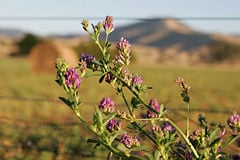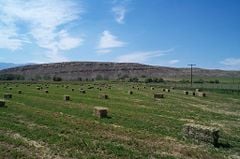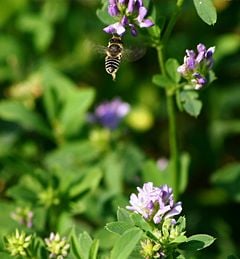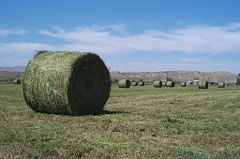Alfalfa
 From Nwe
From Nwe | Alfalfa | ||||||||||||||||||
|---|---|---|---|---|---|---|---|---|---|---|---|---|---|---|---|---|---|---|

Medicago sativa
|
||||||||||||||||||
| Scientific classification | ||||||||||||||||||
|
||||||||||||||||||
|
|
||||||||||||||||||
| Medicago sativa L. |
||||||||||||||||||
|
|
||||||||||||||||||
M. sativa subsp. ambigua |
Alfalfa is a perennial, clover-like legume, Medicago sativa, characterized by a deep taproot, compound leaves typically with three leaflets, and small flowers that often are blue-violet, but may be a variety of colors, including yellow and white. Other common names for Medicago sativa include lucerne, purple medic and trefoil. It also is known as buffalo grass, buffalo herb, and Chilean clover, and as zi mu in Chinese (Longe 2005). Alfalfa is widely cultivated for hay and pasture for livestock, but also is used as source of food for people and as a medicinal herb (Longe 2005).
Alfalfa reflects the harmony in nature via two symbiotic relationships. First, as a member of the legume family, alfalfa has a mutualistic relationship with nitrogen-fixing bacteria, allowing it to convert atmospheric nitrogen into a usable form. In return for this benefit, the microorganisms receive a habitat and a food source. Second, alfalfa has a mutually beneficial symbiotic relationship with bees. The bees receive a food source from the flowers of the alfalfa, while the pollination allows the cross-fertilization necessary for reproduction of the plants.
In a sense, alfalfa also reflects a harmonious relationship with people. Alfalfa has been spread by people throughout the world, ensuring its survival as a species, and bees even have been imported to alfalfa fields for pollination purposes. For humans, alfalfa is a very important agricultural plant, being used to feed livestock (cattle, horses, sheep, etc.), and used in crop rotation to replenish nitrogen and other nutrients in the soil. In terms of human consumption, alfalfa sprouts are used as a salad ingredient, the shoots eaten as a vegetable, the seeds eaten, and the leaves used in making tea. Alfalfa is high in protein and an excellent source of several vitamins (A, D, E, and K) and minerals. Furthermore, both Western and Eastern medicine have found ways to used the whole plant and seeds medicinally.
Description
Medicago sativa is a member of the flowering plant family, Fabaceae (also called Leguminosae). They are one of the largest plant families and include beans, peas, peanuts, lupines, alfalfa, clover, acacia, and many others. Fabaceae is known variously as the legume family, pea family, bean family or pulse family.
All members of this family have five-petaled flowers in which the superior ovary (an ovary attached to the receptacle above the attachment of other floral parts) ripens to form a "pod," technically called a legume, whose two sides split apart, releasing the seeds that are attached to one or both seams.
The legumes are traditionally classified into three subfamilies (in some taxonomies these are raised to the rank of family in the order Fabales), of which alfalfa belongs to the subfamily Faboideae or Papilionoideae. Plants in this subfamily have one petal that is large and has a crease in it, while the two adjacent petals are on the sides, and the two bottom petals are joined together at the bottom, forming a boat-like structure. Most of the legumes, including those well-known as food crops, are in this sub-family.
Most legumes, through a symbiotic relationship with certain bacteria called rhizobia are able to take nitrogen from the air and "fix" it, that is change it into chemical compounds that can be used by plants. This is the process of nitrogen fixation. The nitrogen is then available to be used by animals that eat the legume plants and by other plants when it is absorbed by the soil after the legumes' death.
Alfalfa has a very long, deep (two to five meters) root system (Longe 2005); the long taproot may even reach 15 meters deep. It grows in size from between one-third of a meter to a little less than one meter in height. It has numerous stems (a few to perhaps 50) that arise from a single woody crown set near the soil level. The flowers are often blue-violet or violet in color, but may be yellow, white, green, and other shades. The fruit is a legume, which contains small seeds. Insect pollination, principally by bees allows the necessary cross-fertilization for reproduction.
Alfalfa lives from three to twelve years, depending on variety and climate. It is a cool season perennial legume. Its deep root system allows it to be very resilient, especially to droughts, and it also regrows quickly after cutting, allowing numerous harvesting in one season. Alfalfa is a plant that exhibits autotoxicity, which means that it is difficult for alfalfa seed to grow in existing stands of alfalfa. Therefore, it is recommended that alfalfa fields be cleared or rotated before reseeding.
Alfalfa has a tetraploid genome.
Alfalfa is native to Iran, where it was probably domesticated during the Bronze Age to feed horses being brought from Central Asia. It came to Greece around 490 B.C.E. being used as a horse feed for Persian army. It was introduced from Chile to the United States around 1860. Its wide cultivation beginning in the seventeenth century was an important advance in European agriculture.
Varieties
Considerable research and development has been done with this important plant and many varieties have been developed. Older cultivars such as 'Vernal' have been the standard for years, but many better public and private varieties are available now, and are adapted to the needs of particular climates. Private companies release many new varieties each year in the United States.
Fall dormancy is a major characteristic of alfalfa varieties. More "dormant" varieties have reduced growth in the fall, a response due to low temperatures and reduced day lengths. "Non-dormant" varieties exhibit winter growth activity, and therefore are grown in long-seasoned environments such as Mexico, Arizona, and Southern California, whereas dormant lines are grown in the Upper Midwest, Canada, and the Northeast. Non-dormant lines are susceptible to winter-kill in cold climates, and have poorer persistence, but can be higher yielding.
Most alfalfa cultivars contain genetic material from Sickle Medick (M. falcata), a wild variety of alfalfa that naturally hybridizes with M. sativa to produce Sand Lucerne (M. sativa ssp. varia). This species may bear either the purple flowers of alfalfa or the yellow of sickle medick, and is named for its ready growth in sandy soil.
Most of the improvements in alfalfa over the last decades have been in disease resistance, improved ability to overwinter in cold climates, and multileaf traits. Disease resistance is important because it improves the usefulness of alfalfa on poorly drained soils, and during wet years.
Multileaf alfalfa has more than three leaflets per leaf. These lines may have a higher nutritional content by weight because there is relatively more leafy matter for the same amount of stem.
Modern alfalfa varieties have probably a wider range of insect, disease, and nematode resistance than many other agricultural species.
Uses
Agriculture
Alfalfa is one of the most important legumes used in agriculture. It is widely grown throughout the world as forage for cattle, and is most often harvested as hay. Alfalfa has the highest feeding value of all common hay crops. Its ability to fix nitrogen results in alfalfa producing a high-protein feed regardless of available nitrogen in the soil. When grown on soils where it is well-adapted, alfalfa is the highest yielding forage plant.
Alfafa's primary use is for dairy production, followed by beef, sheep, horses and goats.
Alfalfa's deep root system and ability to fix nitrogen also makes it valuable as a soil improver or "green manure" (Longe 2005). It is used in crop rotation to replenish nitrogen and other nutrients in the soil between plantings of other agricultural plants.
Culinary and nutritional uses
Although used principally for consumption by animals, alfalfa has a history of being used for human consumption as well.
Alfalfa sprouts are used as a salad ingredient in the United States, Australia and New Zealand. Tender shoots are eaten in some places as a leaf vegetable. The seeds are also eaten, and in the early United States were ground and used as a flour (Longe 2005). Human consumption of older plant parts is limited primarily by very high fiber content. Dehydrated alfalfa leaf is commercially available as a dietary supplement in several forms, such as tablets, powders and tea.
Alfalfa is an excellent source of vitamins A, D, E, and K, and is high in protein, and also contains trace amounts of such minerals as calcium, magnesium, iron, phosphorous, and potassium (Longe 2005).
Medicinal uses
The whole plant and seeds are used medicinally in both Western and traditional Chinese medicine (Longe 2005). The main medicinal use in the United States has been as a nutritious tea or tonic, but it also is believed useful to treat arthritis, diabetes, digestive problems, weight loss, hay fever, asthma, and as a diuretic or "water pill" and to lower cholesterol (Longe 2005). Alfalfa is a minor herb in Chinese medicine but has been used since the sixth century for such purposes as to cleanse the digestive system and to rid the bladder of stones; furthermore, the root of alfalfa is used to reduce fever, improve urine flow, and treat jaundice, among other beliefs (Longe 2005).
Longe (2005) notes that while alfalfa is generally harmless, those with the autoimmune disease systemic lupus erythematosus (SLE) should not take any form of alfalfa as a precautionary measure, as a result of some studies where latent SLE was reactivated in people by use of alfalfa and some new cases of SLE arose in monkeys fed alfalfa sprouts and seeds.
Production
The United States is the largest alfalfa producer in the world. The leading alfalfa growing states (within the United_States) are California, South Dakota, and Wisconsin. The upper Midwestern states account for about 50% of US production, the North eastern states 10 percent, and western states 40 percent of US production, the latter mostly under irrigation. However, alfalfa has a wide range of adaptation and can be grown from very cold northern plains to high mountain valleys, from rich temperate agricultural regions to Mediterranean climates and searing hot deserts.
Alfalfa can be sown in spring or fall, and does best on well-drained soils with a neutral pH of 6.8–7.5. Alfalfa requires a great deal of potash. Soils low in fertility should be fertilized with manure or a chemical fertilizer, but correction of pH is particularly important. Usually a seeding rate of 13–20 kg/hectare (12–25 lb/acre) in climatic acceptable regions and a rate of 22 kg/hectare (20 lb/acre) in southern regions is used. A nurse crop is often used, particularly for spring plantings, to reduce weed problems. Herbicides are sometimes used instead.
In most climates, alfalfa is cut three to four times a year but is harvested up to 12 times per year in Arizona and Southern California. Total yields are typically around 8 metric ton/hectare (4 ton/acre) but yields have been recorded up to 20 metric ton/ha (16 ton/acre). Yields vary due to region and with weather, and with stage of maturity when cut. Later cuttings improve yield but reduce nutritional content.
Alfalfa is considered an "insectary" due to the large number of insects which are found there. Some pests such as Alfalfa weevil, aphids, and the potato leafhopper can reduce alfalfa yields dramatically, particularly with the second cutting when weather is warmest. Chemical controls are sometimes used to prevent this. Alfalfa is also susceptible to root rots including phytophora, rhizoctonia, and Texas Root Rot.
Alfalfa seed production requires pollinators to be present in the fields when in bloom. Alfalfa pollination is somewhat problematic because the keel of the flower trips to help pollen transfer to the foraging bee, striking them in the head. Western honey bees do not like being struck in the head repeatedly, and often learn to defeat this action by drawing nectar from the side of the flower, thus pollination is not accomplished (Milius 2007). The majority of the pollination is accomplished by young bees that have not yet learned the trick of robbing the flower without tripping it. When honey bees are used for pollination, the beehives are stocked at a very high rate to maximize the number of young bees.
Today the alfalfa leafcutter bee is increasingly used to circumvent this problem. As a solitary but gregarious bee species, it does not build colonies or store honey, but is a very efficient pollinator of alfalfa seed. Nesting is in individual tunnels in wooden or plastic material, supplied by the alfalfa seed growers (Milius 2007).
A smaller amount of alfalfa seed is pollinated by the alkali bee, mostly in the northwestern United States. It is cultured in special beds near the seed fields. These bees also have their own problems. They are not portable like honey bees; they take several seasons to build up when fields are planted in new areas (Milius 2007). Honey bees are still trucked to many of the fields at bloom time.
Harvesting
When alfalfa is to be used as hay, it is usually cut and baled. Loose haystacks are still used in some areas, but bales are much easier to transport and are easier to keep hold of when being stored. Ideally, the hay is cut just as the field is beginning to flower. When using farm equipment rather than hand-harvesting, the process begins with a swather, which cuts the alfalfa and arranges it in windrows. In areas where drying down of the alfalfa is problematic and slow, a machine know as mower-conditioner is used to cut the hay. The mower-conditioner has either a set of rollers or flails through which the hay passes after being cut which crimps or breaks the stems in order to facilitate faster dry down of the hay.
After the alfalfa has dried, a tractor pulling a baler collects the hay into bales. There are three types of bales commonly used for alfalfa. Small "square" bales—actually rectangular, and typically about 40 x 45 x 100 cm (14 in x 18 in x 38 in)—are used for small animals and individual horses. The small square bales weigh between 25–30 kg (50 – 70 pounds) depending on moisture, and can easily be hand separated into "flakes." Cattle ranches use large round bales, typically 1.4 to 1.8 m (4 to 6 feet) in diameter and weighing up to 500–1,000 kg. These bales can be placed in stable stacks, placed in large feeders for herds of horses, and unrolled on the ground for large herds of cattle. The bales can be loaded and stacked with a tractor using a spike, known as a bale spear, that pierces the center of the bale, or with a grapple (claw) on the tractor's front-end loader. A more recent innovation is large "square" bales, roughly the same proportions as the small squares, but much larger. The bale size is set so that stacks fit perfectly on a large flatbed truck.
When used as feed for dairy cattle, alfalfa is often made into haylage by a process known as ensiling. Rather than drying it down to the level of dry hay it is chopped finely and put into silos, trenches, or bags, where the oxygen supply can be limited allowing it to ferment. This allows it to remain in a state in which the nutrient levels are closer to that of fresh forage, and is more palatable in the high performance diet of dairy cattle.
References
ISBN links support NWE through referral fees
- Hanson, A. A., D. K. Barnes, and R. R. Hill. 1988. Alfalfa and Alfalfa Improvement. Agronomy, no. 29. Madison, Wis., USA: American Society of Agronomy. ISBN 089118094X.
- Longe, J. L. 2005. The Gale Encyclopedia of Alternative Medicine. Farmington Hills, Mich: Thomson/Gale. ISBN 0787693960.
- Milius, S. 2007. Most bees live alone: No hives, no honey, but maybe help for crops. Science News 171(1): 11-13.
Credits
New World Encyclopedia writers and editors rewrote and completed the Wikipedia article in accordance with New World Encyclopedia standards. This article abides by terms of the Creative Commons CC-by-sa 3.0 License (CC-by-sa), which may be used and disseminated with proper attribution. Credit is due under the terms of this license that can reference both the New World Encyclopedia contributors and the selfless volunteer contributors of the Wikimedia Foundation. To cite this article click here for a list of acceptable citing formats.The history of earlier contributions by wikipedians is accessible to researchers here:
The history of this article since it was imported to New World Encyclopedia:
Note: Some restrictions may apply to use of individual images which are separately licensed.
↧ Download as ZWI file | Last modified: 02/03/2023 21:55:11 | 3 views
☰ Source: https://www.newworldencyclopedia.org/entry/Alfalfa | License: CC BY-SA 3.0
 ZWI signed:
ZWI signed:


 KSF
KSF